ZHCSGJ7A July 2017 – October 2017 LM36011
PRODUCTION DATA.
- 1 特性
- 2 应用
- 3 说明
- 4 修订历史记录
- 5 Pin Configuration and Functions
- 6 Specifications
- 7 Detailed Description
- 8 Applications and Implementation
- 9 Power Supply Recommendations
- 10Layout
- 11器件和文档支持
- 12机械、封装和可订购信息
6 Specifications
6.1 Absolute Maximum Ratings
over operating free-air temperature range (unless otherwise noted)(1)(2)| MIN | MAX | UNIT | ||
|---|---|---|---|---|
| IN, OUT, LED | −0.3 | 6 | V | |
| SDA, SCL, STROBE | −0.3 | (VIN+ 0.3) w/ 6 V maximum | ||
| Continuous power dissipation(3) | Internally limited | |||
| Junction temperature, TJ-MAX | 150 | °C | ||
| Storage temperature, Tstg | −65 | 150 | °C | |
(1) Stresses beyond those listed under Absolute Maximum Ratings may cause permanent damage to the device. These are stress ratings only, which do not imply functional operation of the device at these or any other conditions beyond those indicated under Recommended Operating Conditions. Exposure to absolute-maximum-rated conditions for extended periods may affect device reliability.
(2) All voltages are with respect to the potential at the GND pin.
(3) Internal thermal shutdown circuitry protects the device from permanent damage. Thermal shutdown engages at TJ = 150°C (typical) and disengages at TJ = 135°C (typical). Thermal shutdown is ensured by design.
6.2 ESD Ratings
| VALUE | UNIT | |||
|---|---|---|---|---|
| V(ESD) | Electrostatic discharge | Human-body model (HBM), per ANSI/ESDA/JEDEC JS-001(1) | ±1000 | V |
| Charged-device model (CDM), per JEDEC specification JESD22-C101(2) | ±250 | |||
(1) JEDEC document JEP155 states that 500-V HBM allows safe manufacturing with a standard ESD control process.
(2) JEDEC document JEP157 states that 250-V CDM allows safe manufacturing with a standard ESD control process.
6.3 Recommended Operating Conditions
over operating free-air temperature range (unless otherwise noted)(1)(2)| MIN | MAX | UNIT | ||
|---|---|---|---|---|
| VIN | 2.5 | 5.5 | V | |
| Junction temperature, TJ | −40 | 125 | °C | |
| Ambient temperature, TA (3) | −40 | 85 | °C | |
(1) Stresses beyond those listed under absolute maximum ratings may cause permanent damage to the device. These are stress ratings only, and functional operation of the device at these or any other conditions beyond those indicated under recommended operating conditions is not implied. Exposure to absolute-maximum-rated conditions for extended periods may affect device reliability.
(2) All voltages are with respect to the potential at the GND pin.
(3) In applications where high power dissipation and/or poor package thermal resistance is present, the maximum ambient temperature may have to be derated. Maximum ambient temperature (TA-MAX) is dependent on the maximum operating junction temperature (TJ-MAX-OP = 125°C), the maximum power dissipation of the device in the application (PD-MAX), and the junction-to-ambient thermal resistance of the part/package in the application (RθJA), as given by the following equation: TA-MAX = TJ-MAX-OP – (RθJA × PD-MAX).
6.4 Thermal Information
| THERMAL METRIC(1) | LM36011 | UNIT | |
|---|---|---|---|
| YKB (DSBGA) | |||
| 8 PINS | |||
| RθJA | Junction-to-ambient thermal resistance | 117.3 | °C/W |
| RθJC(top) | Junction-to-case (top) thermal resistance | 1.3 | °C/W |
| RθJB | Junction-to-board thermal resistance | 34.3 | °C/W |
| ΨJT | Junction-to-top characterization parameter | 0.5 | °C/W |
| ΨJB | Junction-to-board characterization parameter | 34.6 | °C/W |
(1) For more information about traditional and new thermal metrics, see the Semiconductor and IC Package Thermal Metrics application report.
6.5 Electrical Characteristics
TA = 25°C and VIN = 3.6 V, unless otherwise specified. Minimum and maximum limits apply over the full operating ambient temperature range (–40°C ≤ TA ≤ 85°C).(1)(2)| PARAMETER | TEST CONDITIONS | MIN | TYP | MAX | UNIT | ||
|---|---|---|---|---|---|---|---|
| CURRENT SOURCE SPECIFICATIONS | |||||||
| ILED | Current source accuracy | VIN = 4 V, flash code = 0x7F = 1.5 A (3) | –10% | 1.5 | 10% | A | |
| VIN = 4 V, torch code = 0x7F = 376 mA | –10% | 376 | 10% | mA | |||
| VHR | LED current source regulation voltage | ILED = 1.5 A | Flash | 550 | mV | ||
| ILED = 376 mA | Torch | 350 | |||||
| STEP-UP DC-DC CONVERTER SPECIFICATIONS | |||||||
| VUVLO | Undervoltage lockout threshold | Falling VIN | 2.5 | V | |||
| VIVFM | Input voltage flash monitor trip threshold | Reg 0x02, bits [7:5] = 000 | –3% | 2.9 | 3% | V | |
| IQ | Quiescent supply current | 0.3 | mA | ||||
| ISB | Standby supply current | Device disabled 2.5 V ≤ VIN ≤ 5.5 V |
0.8 | 4 | µA | ||
| STROBE VOLTAGE SPECIFICATIONS | |||||||
| VIL | Input logic low | 2.5 V ≤ VIN ≤ 5.5 V | 0 | 0.4 | V | ||
| VIH | Input logic high | 1.2 | VIN | V | |||
| I2C-COMPATIBLE INTERFACE SPECIFICATIONS (SCL, SDA) | |||||||
| VIL | Input logic low | 2.5 V ≤ VIN ≤ 4.2 V | 0 | 0.4 | V | ||
| VIH | Input logic high | 1.2 | VIN | ||||
| VOL | Output logic low | ILOAD = 3 mA | 400 | mV | |||
(1) Minimum (MIN) and Maximum (MAX) limits are specified by design, test, or statistical analysis. Typical (TYP) numbers are not verified, but do represent the most likely norm. Unless otherwise specified, conditions for typical specifications are: VIN = 3.6 V and TA = 25°C.
(2) All voltages are with respect to the potential at the GND pin.
(3) The ability to deliver 1.5 A of LED current is highly dependent upon the input voltage, LED voltage, ambient temperature and PCB layout. Depending upon the system conditions, it is possible that the device could hit the internal thermal shutdown or thermal scale-back value before the desired flash duration is reached. See Thermal Performance for more details.
6.6 Timing Requirements
| MIN | NOM | MAX | UNIT | ||
|---|---|---|---|---|---|
| t1 | SCL clock period | 2.4 | µs | ||
| t2 | Data in set-up time to SCL high | 100 | ns | ||
| t3 | Data out stable after SCL low | 0 | ns | ||
| t4 | SDA low set-up time to SCL low (start) | 100 | ns | ||
| t5 | SDA high hold time after SCL high (stop) | 100 | ns | ||
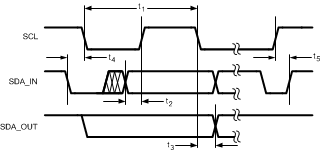 Figure 1. I2C-Compatible Interface Specifications
Figure 1. I2C-Compatible Interface Specifications
6.7 Typical Characteristics
TA = 25°C, VIN = 3.6 V, CIN = 10 µF, VLED = 3.4 V, Flash Time-out = 320 ms and Thermal Scale-Back (TSB) disabled, unless otherwise noted.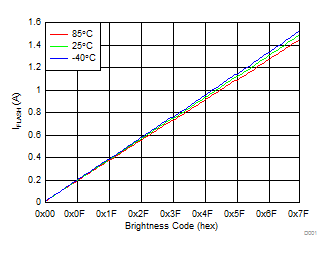
| VIN = 4 V |
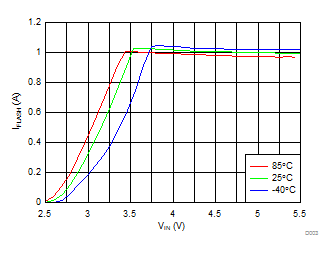
| IFLASH = 1.03 A |
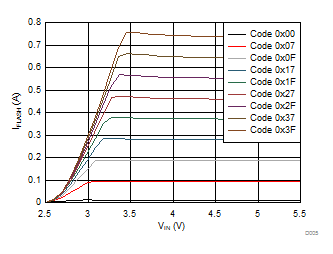
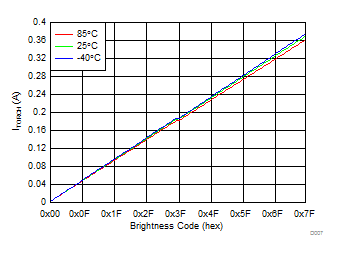
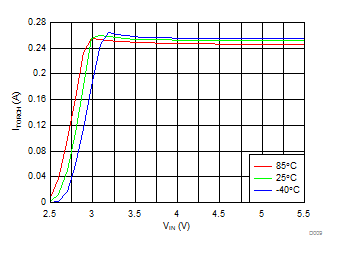
| ITORCH = 258 mA |
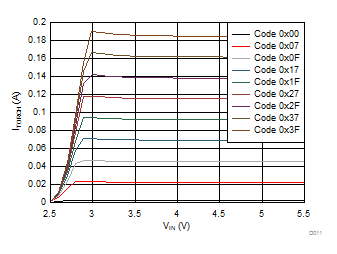
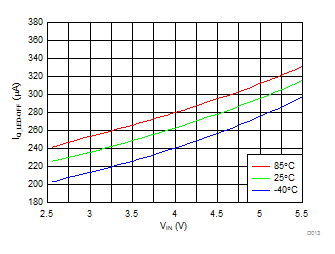
| Mode (Reg 0x01 bits[1:0]) = 01 (IR Mode) | ||
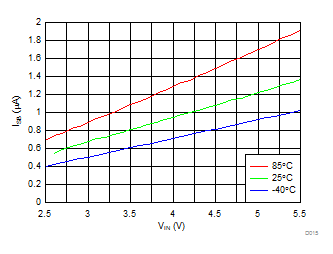
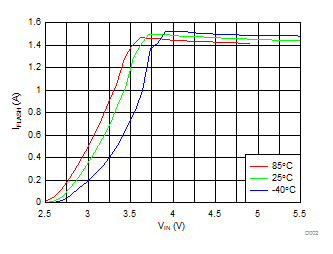
| IFLASH = 1.5 A |
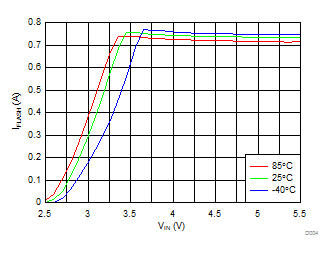
.
Figure 5. LED Flash Current vs Input Voltage
| IFLASH = 0.75 A |
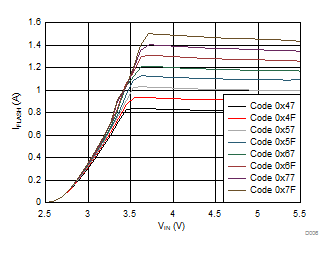
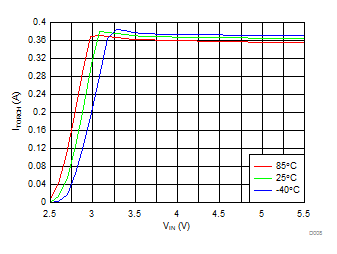
| ITORCH = 376 mA |
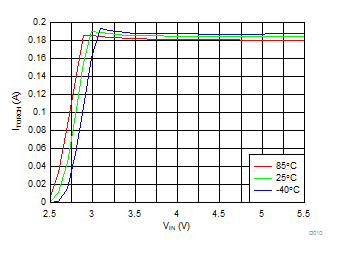
| ITORCH = 188 mA |
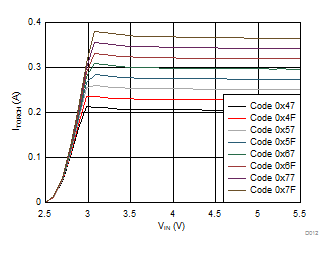
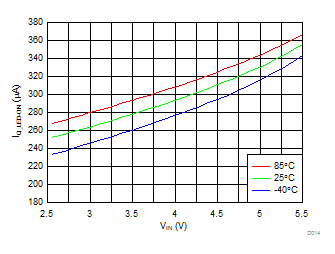
| Mode (Reg 0x01 bits[1:0]) = 10 (Torch Mode) | ||